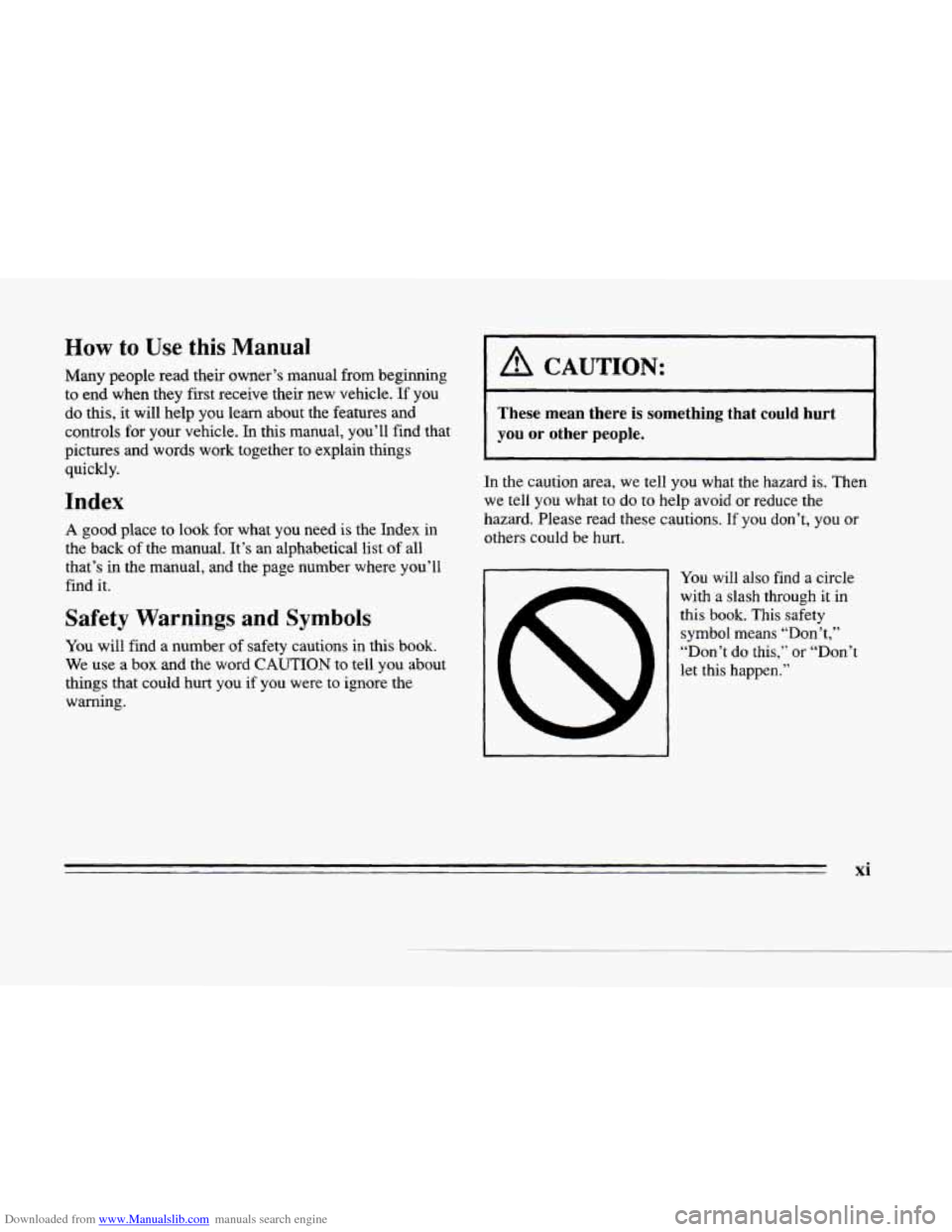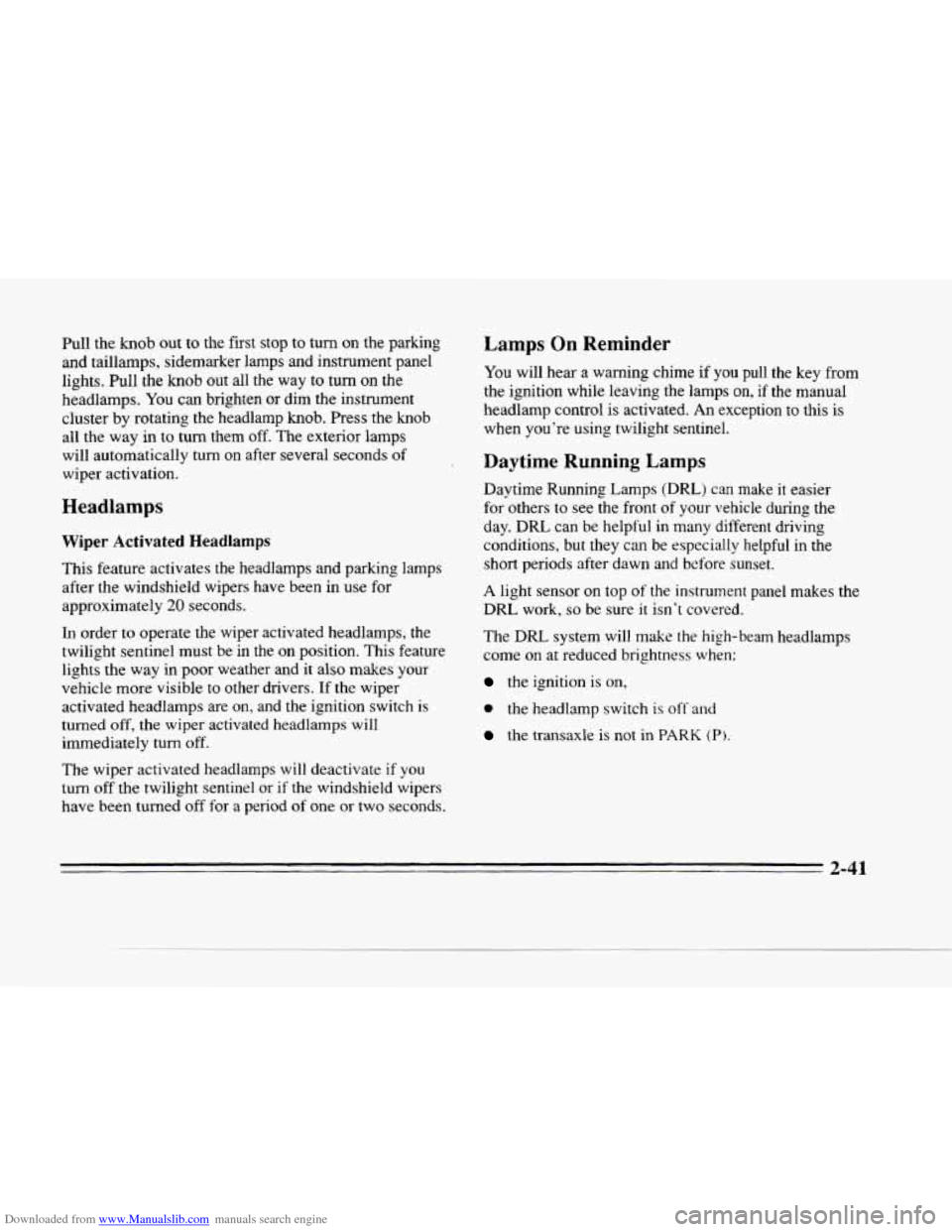1996 CADILLAC SEVILLE warning
[x] Cancel search: warningPage 12 of 354

Downloaded from www.Manualslib.com manuals search engine c
How to Use this Manual
Many people read their owner’s manual from beginning
to end when they first receive their new vehicle. If you
do this, it will help you learn about the features
and
controls for your vehicle. In this manual, you’ll find that
pictures and words work together to explain things
quickly.
Index
A good place to look for what you need is the Index in
the back
of the manual. It’s an alphabetical list of all
that’s in the manual, and the page number where you’ll
find it.
Safety Warnings and Symbols
You will find a number of safety cautions in this book.
We use a box and the word
CAUTION to tell you about
things that could hurt you if you were
to ignore the
warning.
A CAUTION:
These mean there is something that could hurt
you or other people.
In the caution area, we tell you what the hazard is. Then
we tell
you what to do to help avoid or reduce the
hazard. Please read these cautions. If
you don’t, you or
others could be hurt.
You will also find a circle
with
a slash through it in
this book. This safety
symbol means “Don’t,”
“Don’t do this,” or “Don’t
let this happen.”
xi
Page 13 of 354

Downloaded from www.Manualslib.com manuals search engine Vehicle Damage Warnings
Also, in this book you will find these notices:
I NOTICE:
These mean there is something that could
damage your vehicle.
In the notice area, we tell you about something that can
darnage your vehicle. Many times, this damage would
not be covered by your warranty, and
it could be costly.
But the notice will tell you what to do to help avoid the
damage.
When you read other manuals, you might see
CAUTION
and NOTICE wamings in different colors or in different
words.
You’ll also see warning labels on your vehicle. They use
the same words, CAUTION
or NOTICE.
L
Page 14 of 354

Downloaded from www.Manualslib.com manuals search engine e
e
c
Vehicle Symbols
These are some of the symbols you will find on your vehicle.
For example,
these symbols
are used
on an
original battery:
POSSIBLE A
CAUTION
INJURY
PROTECT
EYES BY
SHIELDING
CAUSTIC
BURNS AVOID
SPARKS
OR
FLAMES
SPARK
OR ,111,
COULD FLAME
EXPLODE BAllERY
These symbols
are important
for you and
your passengers
whenever your
vehicle
is
driven:
DOOR LOCK
UNLOCK
FASTEN SEAT
BELTS
POWER
WINDOW
These symbols have
to do with
your lights:
SIGNALS e
TURN
RUNNING
0
DAYTIME -
LAMPS -**
FOG LAMPS # 0
These symbols are on
some of
your controls:
WINDSHIELD
WIPER
WINDSHIELD DEFROSTER
WINDOW
DEFOGGER
VENTILATING FAN
These symbols
are used on
warning and
indicator lights:
COOLANT -
TEMP -
CHARGING I-1
BATTERY
SYSTEM
BRAKE
(a)
COOLANT a
ENGINE OIL w,
PRESSURE
ANTI-LOCK
(,)
BRAKES
Here are some
other symbols
you may see:
FUSE
LlGl ITER D
HORN k3
SPEAKER
k
FUEL B
xiii
Page 60 of 354

Downloaded from www.Manualslib.com manuals search engine ,-L- -*-,
Section 2 Features and Controls
Here you can learn about the many standard and optional
features on your Cadillac, and information on starting,
shrfting and braking. Also explained are the instrument
panel
and the warning systems that tell you if everything is
working properly -- and what to do if you have a problem.
Keys
A CAUTION:
Leaving young children in a vehicle with the
ignition key
is dangerous for many reasons. A child
or others could be badly injured
or even killed.
They could operate power windows or other
controls or even
make the vehicle move. If they
turned the ignition to
on and moved the shift
lever out
of PARK (P), that would release the
parking brake. Don't leave the keys in
a vehicle
with young children.
3:
yl . . . . . ,.
2-1
Page 92 of 354

Downloaded from www.Manualslib.com manuals search engine rrr
xz
e
If the turn signal is left on, a warning chime will sound
and the
DIC will display TURN SIGNAL ON (after
driving about a mile) to remind you to turn it off.
Arrows that
flash rapidly when signaling for a turn or
lane change may be caused by
a burned out signal bulb.
Other drivers won’t see the turn signal.
Replace burned
out bulbs to help avoid possible
accidents. Check the fuse (see “Fuses and Circuit
Breakers”
in the Index) and for burned-out bulbs if the
arrow fails
to work when signaling a turn.
Headlamp High/Low Beam
Pull the turn signal lever all
the way toward you and
then release
it to change the
headlamps from low beam
to high or from high beam
to low. The blue light on the
instrument panel will be on
indicating high-beam usage.
Flash-To-Pass
This lets you use the high-beam headlamps to signal the
driver in front
of you that you want to pass. It works
even if
the headlamps are off.
Pull the turn signal lever toward you to use. When you do:
0 If the headlamps are off, the high-beam headlamps
will turn on. They’ll stay on as
long as you hold the
lever there. Release the lever to turn them off.
If the headlamps are on low beam, they will shift to
high beam and stay there. Pull
the lever toward you
to return to low beam.
0 If the headlamps are on high beam, they will switch
to low beam. To return to high beam, pull the lever
toward
you.
2-33
Page 100 of 354

Downloaded from www.Manualslib.com manuals search engine c
c
Pull the knob out to the first stop to turn on the parking
and taillamps, sidemarker lamps and instrument panel
lights. Pull the knob out all the way to turn
on the
headlamps.
You can brighten or dim the instrument
cluster by rotating the headlamp
knob. Press the knob
all the way in to turn them off. The exterior lamps
will automatically turn
on after several seconds of
wiper activation.
Headlamps
Wiper Activated Headlamps
This feature activates the headlamps and parking lamps
after the windshield wipers have been in use for
approximately
20 seconds.
In order to operate the wiper activated headlamps, the
twilight sentinel must be in the
on position. This feature
lights the way in poor weather and
it also makes your
vehicle more visible to other drivers.
If the wiper
activated headlamps are on, and the ignition switch
is
turned off, the wiper activated headlamps will
immediately turn
off.
The wiper activated headlamps will deactivate if you
turn off the twilight sentinel or if the windshield wipers
have been turned
off for a period of one or two seconds.
Lamps On Reminder
You will hear a warning chime if you pull the key from
the ignition while leaving the lamps on, if the manual
headlamp control is activated. An exception to this is
when you're using twilight sentinel.
Daytime Running Lamps
Daytime Running Lamps (DRL) can make it easier
for-others
to see the front of your vehicle during the
day, DRL can be helpful in many different driving
conditions, but they can be especially helpful in the
short periods after dawn and before sunset.
A light sensor on top of the instrument panel makes the
DRL work,
so be sure it isn't covered.
The
DRL system will make the high-beam headlamps
come on at reduced brightness when:
the ignition is on,
0 the headlamp switch is oft' and
the transaxle is not in PARK (P).
- 2-41
Page 124 of 354

Downloaded from www.Manualslib.com manuals search engine c
L
Engine Speed Limiter
This feature prevents the engine from operating at too
many revolutions per minute (rpm). When the engine
rpm’s are critically high, the fuel supply to the engine
is shut off. When the engine speed slows, the fuel
supply will come on again. This helps prevent damage
to the engine.
Vehicle Speed Limiter (270 hp)
This feature prevents your vehicle from exceeding
speeds that the tires are not rated for. When this
happens, the engine’s fuel supply is shut
off. When the
vehicle speed slows, the fuel supply will come on again.
Warning Lights, Gages and
Indicators
This part describes the warning lights and gages that
may be on your vehicle. The pictures will help you
locate them.
Warning lights
and gages can signal that something is
wrong before it becomes serious enough to cause
an
expensive repair or replacement. Paying attention to
your warning lights and gages could also save you
or
others from injury. Warning
lights come on when there may be or is a
problem with one
of your vehicle’s functions. As you
will see
in the details on the next few pages, some
warning lights come on briefly when you start the
engine just to let you know they’re working. If you
are
familiar with this section, you should not be alarmed
when this happens.
crages can indicate when there may be or is a problem
with one of your vehicle’s functions. Often gages and
warning lights work together to let you know when
there’s a problem with your vehicle.
When one of the warning lights comes on and stays on
when you are driving, or when one of the gages shows
there may be a problem, check the section that tells you
what to do about
it. Please follow this manual’s advice.
Waiting to do repairs can be costly
-- and even
dangerous.
So please get to know your warning lights
and gages. They’re a big help.
Your vehicle may
also have a driver information system
that works along with the warning lights and gages. See
“Driver Information Center” in the Index.
2-65
Page 126 of 354

Downloaded from www.Manualslib.com manuals search engine r
f I
r
r ,
I-
r
r
Charging System Indicator Light
When you turn the key to
RUN, this light will cDme
on briefly to show that the
alternator and battery
charging systems
are working.
If this light stays on,
you need service and you should
take
your Cadillac to the dealer at once. To save your
battery until you get there, turn
off all accessories.
Brake System Warning Light
If this warning light comes on, there could be a brake
problem. Have your brake system inspected right away.
BRAKE
This light should come
on briefly when you turn
the igmtion key to
RUN.
If it doesn’t come on then,
have
it fixed so it will. be
ready to
warn you if there’s
a problem.
If the light comes on while you are driving, pull off the
road and stop carefully. You
may notice that the pedal is
harder to push. Or, the pedal
may go closer to the floor.
It may take longer to stop.
If the light is still on, have the
vehicle towed for service. (See
”Towing Your Vehicle”
in the Index.)
2-67